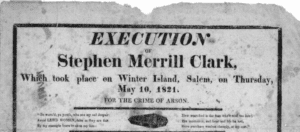 On May 10, 1821, thousands of Salem residents gathered solemnly on Winter Island, a lonely peninsula jutting into Salem Harbor, to witness the execution of a young man named Stephen Merrill Clark. His crime? Arson—specifically, setting fire to a barn in nearby Newburyport. In early 19th-century Massachusetts, property crimes like arson carried a penalty as severe as murder: death by hanging. Yet, from the day of his arrest until his final moments on the gallows, Clark repeatedly proclaimed his innocence, casting a long shadow of controversy and suspicion that endures nearly two centuries later. Was Clark truly guilty, or was an innocent man executed under Salem’s dark skies?
On May 10, 1821, thousands of Salem residents gathered solemnly on Winter Island, a lonely peninsula jutting into Salem Harbor, to witness the execution of a young man named Stephen Merrill Clark. His crime? Arson—specifically, setting fire to a barn in nearby Newburyport. In early 19th-century Massachusetts, property crimes like arson carried a penalty as severe as murder: death by hanging. Yet, from the day of his arrest until his final moments on the gallows, Clark repeatedly proclaimed his innocence, casting a long shadow of controversy and suspicion that endures nearly two centuries later. Was Clark truly guilty, or was an innocent man executed under Salem’s dark skies?
The Crime: A Town’s Loss and Swift Accusations
In the winter of 1820, the city of Newburyport was shaken by a devastating barn fire that rapidly spread, destroying valuable property and livestock. Fearful citizens demanded immediate justice, and local authorities felt pressured to provide a swift resolution. Stephen Merrill Clark, described in contemporary newspapers as a wandering laborer and sometimes sailor, was quickly apprehended. Authorities claimed they found circumstantial evidence linking him to the scene of the crime. Yet, notably absent from the historical record was any eyewitness testimony directly placing Clark at the fire’s origin.
The Salem Gazette reported extensively on the trial, but a deeper analysis reveals that much of the evidence presented against Clark hinged on rumor, hearsay, and local prejudice against itinerant laborers—raising legitimate doubts that continue to haunt historians today.
Trial and Controversy: Miscarriage of Justice?
Clark’s trial, according to archived accounts, was swift and emotionally charged. Historical records suggest the court proceedings were heavily influenced by community fear and prejudice rather than solid evidence. Salem was no stranger to mob justice—only a century earlier, in 1692, the infamous Salem Witch Trials demonstrated how panic and prejudice could corrupt legal proceedings.
Witness accounts from the trial indicate Clark remained steadfast, maintaining his innocence until the very end. Despite his pleas, Clark was sentenced to death, condemned to hang on Winter Island—a place that would soon become synonymous with sorrow and spectral sightings.
The Public Spectacle: Salem’s Morbid Fascination
On the day of Clark’s execution, crowds numbering in the thousands poured onto Winter Island. Families picnicked, and vendors sold refreshments, transforming a grim event into a macabre spectacle. Clark, led up to the scaffold, reportedly faced the crowd with calm defiance. The Salem Gazette described Clark’s demeanor as dignified, noting that he loudly proclaimed his innocence once again before the executioner carried out his grim duty.
After Clark’s execution, his body was quickly buried nearby in an unmarked grave, reinforcing the sense of injustice. This anonymity fueled local whispers, many believing an innocent man was wrongfully silenced and discarded, haunting Salem’s collective conscience for generations.
Hauntings and the Lingering Legacy on Winter Island
Almost immediately following Clark’s burial, locals began reporting unexplained events around the execution site. Over the decades, paranormal enthusiasts, historians, and casual visitors alike have described phenomena including:
-
Phantom Cries: Witnesses claim to hear distant cries of anguish echoing near the gallows site—especially on the anniversary of Clark’s execution.
-
Shadow Figures: Visitors frequently report seeing a solitary shadowy figure wandering aimlessly at dusk, vanishing upon closer approach.
-
EMF Spikes: Modern paranormal investigators consistently record unexplained electromagnetic field fluctuations precisely where Clark was executed.
Modern Historical Re-Evaluations
Today, many Salem historians believe Clark was, in fact, innocent—a victim of the harsh, uncompromising justice system of early America. Several contemporary scholars argue Clark was targeted because of his transient status, a convenient scapegoat for a fearful and angry community. These revelations continue to spark renewed interest in Clark’s case, both academically and paranormally, driving modern curiosity and skepticism.
An Archival Glimpse: Original Salem Gazette Coverage
To explore the original contemporary accounts of Clark’s tragic end, you can delve into archived newspaper clippings directly via the Chronicling America digital archive. These invaluable primary sources offer deeper insight into how society grappled with crime, punishment, and morality in early-19th-century Salem.
Final Reflections: Unresolved Questions and Enduring Mysteries
Nearly two centuries later, Stephen Merrill Clark’s story remains deeply compelling precisely because of the unanswered questions. Was justice served on Winter Island, or did Salem sacrifice an innocent man in the name of public fear and prejudice? Perhaps the paranormal phenomena surrounding Clark’s execution site is his way of continuing to protest his innocence, echoing across time.
Ready to Uncover Salem’s Darkest Secrets for Yourself?
Experience Salem’s chilling history firsthand. Join our immersive, small-group ghost tour and explore Salem’s haunted legacy—including Winter Island’s restless grounds.